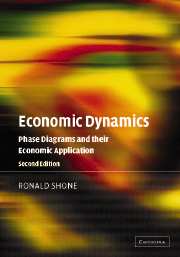Book contents
- Frontmatter
- Contents
- Preface to the second edition
- Preface to the first edition
- PART I Dynamic modelling
- 1 Introduction
- 2 Continuous dynamic systems
- 3 Discrete dynamic systems
- 4 Systems of first-order differential equations
- 5 Discrete systems of equations
- 6 Optimal control theory
- 7 Chaos theory
- PART II Applied economic dynamics
- Answers to selected exercises
- Bibliography
- Author index
- Subject index
7 - Chaos theory
Published online by Cambridge University Press: 05 June 2012
- Frontmatter
- Contents
- Preface to the second edition
- Preface to the first edition
- PART I Dynamic modelling
- 1 Introduction
- 2 Continuous dynamic systems
- 3 Discrete dynamic systems
- 4 Systems of first-order differential equations
- 5 Discrete systems of equations
- 6 Optimal control theory
- 7 Chaos theory
- PART II Applied economic dynamics
- Answers to selected exercises
- Bibliography
- Author index
- Subject index
Summary
Introduction
The interest and emphasis in deterministic systems was a product of nineteenth-century classical determinism, most particularly expressed in the laws of Isaac Newton and the work of Laplace. As we pointed out in chapter 1, if a set of equations with specified initial conditions prescribes the evolution of a system uniquely with no external disturbances, then its behaviour is deterministic and it can describe a system for the indefinite future. In other words, it is fully predictable. This view has dominated economic thinking, with its full embodiment in neoclassical economics. Furthermore, such systems were believed to be ahistoretic. In other words, such systems were quite reversible and would return to their initial state if the variables were returned to their initial values. In such systems, history is irrelevant. More importantly from the point of view of economics, it means that the equilibrium of an economic system is not time-dependent.
Although the physical sciences could in large part undertake controlled experiments and so eliminate any random disturbances, this was far from true in economics. This led to the view that economic systems were subject to random shocks, which led to indeterminism. Economic systems were much less predictable. The random nature of time-series data led to the subject of econometrics. The subject matter of econometrics still adheres to the view that economic systems can be captured by deterministic components, which are then augmented by either additive or multiplicative error components.
- Type
- Chapter
- Information
- Economic DynamicsPhase Diagrams and their Economic Application, pp. 286 - 322Publisher: Cambridge University PressPrint publication year: 2002

